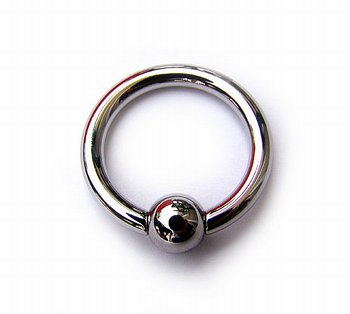Captive bead ring: Difference between revisions
Jump to navigation
Jump to search
(Created page with "<html><div class="mw-content-ltr" dir="ltr" id="mw-content-text" lang="en"><div class="floatright"><a class="image" href="/index.php?title=File:Cbr-1.jpg"><img alt="Cbr-1.jpg" height="314" src="/images/a/a3/Cbr-1.jpg" width="350"/></a></div> <p>A <b>captive bead ring</b> (or <b>CBR</b>) — also known as a <b>captive ball ring</b>, <b>ball closure ring</b> or <b>BCR</b> — is a ring used in body <a href="/index.php?title=Piercing" title="Piercing">piercing</a> where the...") |
(Page conversion via llm-mediawiki-rev -jwm) |
||
| Line 1: | Line 1: | ||
[[File:Cbr-1.jpg|thumb|right|350px]] | |||
A '''captive bead ring''' (or '''CBR''') — also known as a '''captive ball ring''', '''ball closure ring''' or '''BCR''' — is a ring used in body [[Piercing|piercing]] where the bead is held in place solely by the spring pressure of the metal. It is probably the most common [[Jewelry|jewelry]] used in piercings. | |||
A CBR is opened by using either hand pressure on smaller [[Gauge|gauges]] or using [[Ring opener|ring openers]] for heavier rings. High-quality pieces have rounded ends to smoothly fit through the piercing and no gaps between the ring and ball which could catch or grab skin. | |||
== See Also == | |||
* [[Segment Ring]] | |||
* [[Bar Closure Ring]] | |||
* [[Circular barbell]] | |||
* [[Anneal]] | |||
* [[Jewelry Acronyms]] | |||
Latest revision as of 01:12, 17 September 2023
A captive bead ring (or CBR) — also known as a captive ball ring, ball closure ring or BCR — is a ring used in body piercing where the bead is held in place solely by the spring pressure of the metal. It is probably the most common jewelry used in piercings.
A CBR is opened by using either hand pressure on smaller gauges or using ring openers for heavier rings. High-quality pieces have rounded ends to smoothly fit through the piercing and no gaps between the ring and ball which could catch or grab skin.
